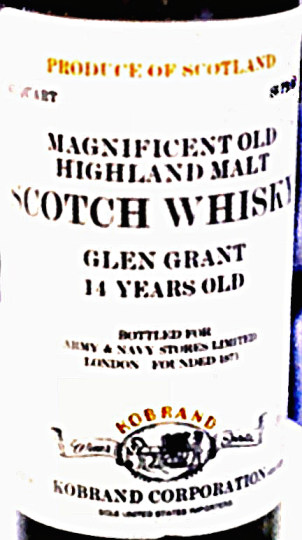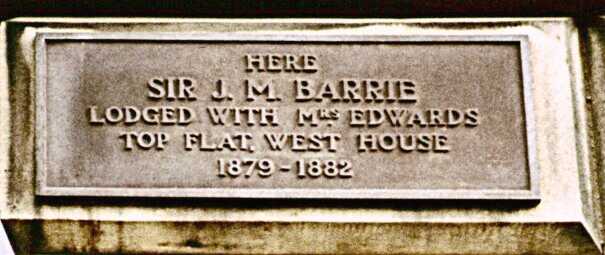Supplementary Information and Illustration
It would be too much like work to blend the following points into the body of the Prolegomena, and besides if I did so then anybody who wanted to read it who had read the Prolegomena already would have to plow through it again to find it, so I just took the easy way out and made it a supplement. Or, if you prefer, an appendix. Or, if you are so inclined, a semicolon. (Well, there's the ascending colon, the transverse colon, the descending colon, and the ...)
What happened was that I finally broke down and treated myself to a digital camera of decent quality in order to be able to record the important research data on the labels of those members of the Reference Collection which no longer contained research material. I didn't want to risk soaking the labels off and I didn't have the heart to throw the bottles out without memoria, but the number of dead soldiers was getting uncomfortably large, so taking pictures of the labels seemed to be a reasonable way of crafting headstones before finally seeing what would happen if I did try to soak the labels off and chucking the bottles regardless. And give or take a great deal of difficulty with achieving appropriate illumination, that more or less worked--at least to the point of having close enough to acceptable versions of all the current corpses that I decided it was time for a change before attempting a more refined pass over the collection.
Having consulted with a friend who's quite knowledgeable about digital cameras (indeed, one of the things he's working on is a Photoshop filter for removing scratches from digital captures of slides) before I made the camera purchase, I'd learned that another use for decent quality ones is in fact making digital captures of slides. So I figured I'd have a go at that, both as a break from the headstones project and as a way of protecting my investment in the camera in the first place. After all, I do have a fair number of not only 35 mm but even worse "half-frame" 35 mm slides in one of the hall closets and making selected ones accessible via the wintel box ought to be a good thing--and maybe even a Good Thing.
Not an unmixed blessing, though. It turns out that capturing slides is tricky enough to begin with and then often demands an inordinate amount of retouching and/or enhancing to continue with. So when I came across a couple of slides so old I'd forgotten I even had them which had vast Research Significance--and to make matters worse, one of them was a half-frame--my carpal tunnels nearly did finally cave in after my efforts to touch them up appropriately. But I did want them to be good enough to "share" because they really were extremely significant, so I let the favor balance tilt even further askew with said knowledgeable friend and implored him to put on the full court press: i.e., use his special separate slide-digitizing peripheral widget on the two slides in question in order to give me the best possible capture with which to play (since, of course, even that mighty widget didn't emit bits that didn't need diddling).
Naturally, with my usual luck, that led to versions which weren't both sufficiently improvable; and unnaturally, the half-frame one was, but the full-frame one wasn't, and you already know, I'm sure, which was the more Significant. And naturally I didn't have the heart to beg still another favor....
In telling the tale of woe to still another friend (who was visiting for a bit of lab work with the Reference Collection at the time, as it happens), however, it turned out that he had developed some expertise in retouching and/or enhancing and volunteered to see what he could do. Despite his best efforts, though, it still came out looking awfully grimy, so I decided to settle for the result of several further passes (this time with "The GIMP") over a version I'd already churned out which had been subjected to vicious tweaking of the contrast and brightness, even if it does look somewhat unnatural as a result of the obscene ministrations.
Check back sometime after, say, the first few months of 2002, though; I subsequently told the tale to John, who owned the original item of which the picture was taken, in hopes he'd remember whether the label in question actually was tinted, and it turns out he'd had the extreme good taste to've saved the bottle and has promised to see what luck he has with scanning or shooting it, so there might be a much better picture available at some point in time. (To save further editing and uploading fuss, if it comes off I'll just slide the better one in under the same plinkable, b/t/w.)
Figure 1, then, is the best we could do (as of now; another of those literary foreshadowings ... I'll also slide a better one in under the plinkable if anybody ever finds a "filter" that does deal with the blotchiness which ruins the look of the ones that weren't subjected to unnatural contrast/brightness acts, as well as if John's efforts pay off, of course) with what started out to be a picture of the label on the actual bottle that started the Research, taken on the very day the Research was conceived.

Yes, it's the bottle out of which came the transcendentally smooth Glen Grant Magnificent Old Highland Malt. And it turns out I can now date the experience to within a month for so, since it happens that May 1978 was embossed into the cardboard frame the slide was mounted in. Even if it took me awhile to get around to having the film processed, then, at least we know that the epiphany took place in the Spring of '78, which is more than we were sure of until we happened across the slide in question.
And then there's Figure 2. That takes a little explaining, but before doing so it's worth noting that it was indeed the half-frame slide from which it was captured and I'm frankly downright impressed and nearly amazed at the amount of detail the magic peripheral managed to wring out of it. Granted, the color is probably way off after my tweaking, but unlike the versions I did with the camera, you can actually make out the funny little Mrs. mark and the range of years in this one, and that was rather impressive.

How it ties in with the Research won't be obvious, though, unless you were a close reader of the "Malts List" on the 'Net in the nominally good old days (or least the days when I was its most frequent contributor). Some agitator had sent a message containing Michael Jackson's "scores" for several whiskies and Jackson had in my humble but dogmatic opinion given Glenfarclas far too low a number. (That's the beer and booze writing Jackson, of course, not the lips- and body-writhing one—nor the UK based COBOL expert neither! nor the one who makes his living talking on radio in Los Angeles either, if you've heard of him.) My response to the provocation was to tell The Man In The Street Story, which I happen to be able to reproduce below, and it almost goes without saying that Figure 2 is a picture of the very plaque that led to the story.
And even though I've been using the somewhat awkward, inconvenient, and decidedly time-consuming " ViaVoice " widget to spare my still touchy wrists and fingers for the first draft of this, that's probably more than enough new stuff. So here comes the Story, and that'll be it for the Supplement, despite the guilt i feel over not being up to using the occasion to goad myself into finally writing the promised/threatened tirade about "grades" vs. "scores" that would tie in rather neatly right after the Story:
Once upon a time (August of '89 I believe it was, actually), I was walking through the New Town section of Edinburgh and spotted a plaque on a building (the exact location of which could be reconstructed if it had to be) to the effect that in 189something Sir James Barrie had visited with Mrs. Somebody in Flat soandso for I think it was some several months, perhaps even more than a year's worth. Wanting to add it to my collection of signs I found amusing, I got my tactful little half-frame 35mm camera out of my pocket and started lining up a shot. A man who appeared to be in his 80s came out of the door and looked quizzically at me, so I explained that Barrie's name had caught my eye and I thought I'd like a souvenir photo. "Ah, yes," he said, "famous literary gent." "Indeed," I replied, "the name did ring a bell. Or perhaps a Tinker bell."
Perhaps because of or perhaps despite that, we got to talking. When I mentioned that I was there both for Festival and for Research, he asked me what my favo[u]rite malt whisky was. I replied that two days out of five it was the [then-available] 12 year old Lagavulin and three days out of five it was the 18 year old Macallan. "Ach, too sweet," he said. "Well," I said, "I admit that the influence of the sherry casking might not be to everyone's taste, and I must say I'm also quite fond of the Glenfarclas, which is perhaps a better exemplar of the classic Highland style." By this time, his lady wife had joined us, and when I said that (and I really did say that), she beamed and said "He owned the maltings!"
Now, clearly it would make a better story had they invited me in for a dram of something special, but as it happened they didn't. I still found it a charming and, clearly, memorable occasion in its own right, though, and if by any chance Michael Jackson is "lurking"--or if some agitator (I name no names) is in touch with him offline--let the record show that even the man in the street thinks extremely well of Glenfarclas.
© 2001 M.A. Padlipsky, 2011, 2021 William D Ricker d/b/a Literary Estate of M.A.Padlipsky